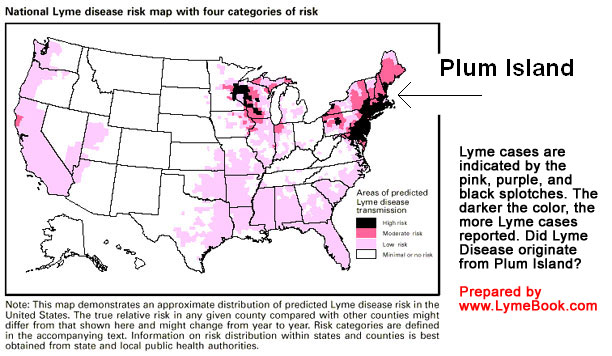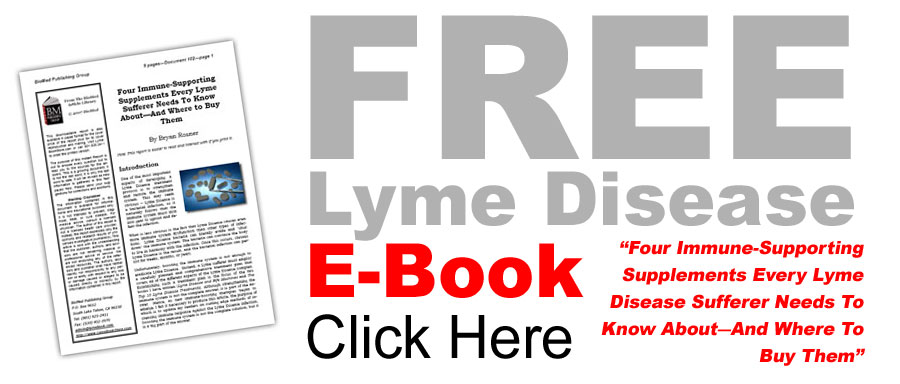| Proof that Plum Island experimented with tick-borne
diseases
 The
question is often asked: Is there any actual proof that the
government-run, Plum Island research facility experimented with
tick-borne diseases? The
question is often asked: Is there any actual proof that the
government-run, Plum Island research facility experimented with
tick-borne diseases?
This
question is important because many modern hypothesis (or conspiracy
theories?) state that Lyme disease itself may have originated from an
accidental (or intentional?) leak of bacteria from Plum Island into
mainland USA (hence the strong geographical centricity of Lyme disease
on the East Coast.
The below studies were all conducted at the plum
island research facility, proving that this facility did in fact
experiment with tick-borne diseases. Accordingly, there can be no more
questions about if Plum Island did in fact dabble in these infections.
Questions still remain: did Plum Island workers actually create Lyme
disease as some bio-warfare germ? Does any official know the story, but
hide it due to fear of indictment or worse? What type of cover-up's
ensued after Lyme disease was "leaked" to mainland USA? How
did Lyme disease get to become a world-wide problem? My guess is we'll
probably never know the answers to these questions, but in the meantime,
at least we know there is proof that the questions aren't being asked in
vane. Likely the most convincing reason to believe in the dangerous
experiments and leaks that occurred at Plum Island is the fact that Lyme
disease cases are clustered around Plum Island according to the CDC.
Furthermore, historically, as the disease spread throughout the country,
it's pattern of spread originated from the Plum Island region outward
toward the Midwest, South, Plains, Southwest, and Western United States.
See map:

The Plum Island
Studies
Click the links to see that the studies were in fact conducted at Plum
Island
1. African swine fever
virus multigene family 360 genes affect virus
replication and generalization of infection in Ornithodoros
porcinus ticks.
(http://www.ncbi.nlm.nih.gov/pubmed/14963141
)
Burrage TG, Lu Z, Neilan JG, Rock DL, Zsak L.
J Virol. 2004 Mar;78(5):2445-53.PMID: 14963141 [PubMed -
indexed for
MEDLINE] Related articles
(http://www.ncbi.nlm.nih.gov/sites/entrez?db=pubmed&cmd=link&linkname=pubmed_pubmed&uid=14963141
) _Free article_
(http://www.ncbi.nlm.nih.gov/pubmed/14963141
)
2. African swine fever virus replication in the midgut epithelium is
required for infection of Ornithodoros ticks.
(http://www.ncbi.nlm.nih.gov/pubmed/10482612
)
Kleiboeker SB, Scoles GA, Burrage TG, Sur J.
J Virol. 1999 Oct;73(10):8587-98.PMID: 10482612 [PubMed -
indexed for
MEDLINE] Related articles
(http://www.ncbi.nlm.nih.gov/sites/entrez?db=pubmed&cmd=link&linkname=pubmed_pubmed&uid=10482612
) Free article
(http://www.ncbi.nlm.nih.gov/pubmed/10482612
)
3. A conserved African swine fever
virus right variable region gene, l11L,
is non-essential for growth in vitro and virulence in domestic
swine.
(http://www.ncbi.nlm.nih.gov/pubmed/9603334
)
Kleiboeker SB, Kutish GF, Neilan JG, Lu Z, Zsak L, Rock DL.
J Gen Virol. 1998 May;79 ( Pt 5):1189-95.PMID: 9603334 [PubMed -
indexed
for MEDLINE] Related articles
(http://www.ncbi.nlm.nih.gov/sites/entrez?db=pubmed&cmd=link&linkname=pubmed_pubmed&uid=9603334
) Free article
(http://www.ncbi.nlm.nih.gov/pubmed/9603334
)
4. African swine fever virus infection in the argasid host, Ornithodoros
porcinus porcinus. (http://www.ncbi.nlm.nih.gov/pubmed/9499019
)
Kleiboeker SB, Burrage TG, Scoles GA, Fish D, Rock DL.
J Virol. 1998 Mar;72(3):1711-24.PMID: 9499019 [PubMed -
indexed for
MEDLINE] Related articles
(http://www.ncbi.nlm.nih.gov/sites/entrez?db=pubmed&cmd=link&linkname=pubmed_pubmed&uid=9499019
) Free article
(http://www.ncbi.nlm.nih.gov/pubmed/9499019
)
5. A BIR motif containing gene of African swine fever virus, 4CL,
is
nonessential for growth in vitro and viral virulence.
(http://www.ncbi.nlm.nih.gov/pubmed/9143281
)
Neilan JG, Lu Z, Kutish GF, Zsak L, Burrage TG, Borca MV, Carrillo
C, Rock
DL.
Virology. 1997 Apr 14;230(2):252-64.PMID: 9143281 [PubMed -
indexed for
MEDLINE] Related articles
(http://www.ncbi.nlm.nih.gov/sites/entrez?db=pubmed&cmd=link&linkname=pubmed_pubmed&uid=9143281
)
6. Attempted transovarial and venereal transmission of African swine
fever
virus by the Iberian soft tick Ornithodoros (Pavlovskyella) marocanus
(Acari: Ixodoidea: Argasidae). (http://www.ncbi.nlm.nih.gov/pubmed/8057310
)
Endris RG, Hess WR.
J Med Entomol. 1994 May;31(3):373-81.PMID: 8057310 [PubMed -
indexed for MEDLINE] Related articles
(http://www.ncbi.nlm.nih.gov/sites/entrez?db=pubmed&cmd=link&linkname=pubmed_pubmed&uid=8057310
)
7. African swine fever virus infection in the soft tick, Ornithodoros
(Alectorobius) puertoricensis (Acari: Argasidae).
(http://www.ncbi.nlm.nih.gov/pubmed/1460641
)
Endris RG, Haslett TM, Hess WR.
J Med Entomol. 1992 Nov;29(6):990-4.PMID: 1460641 [PubMed -
indexed for
MEDLINE]Related articles
(http://www.ncbi.nlm.nih.gov/sites/entrez?db=pubmed&cmd=link&linkname=pubmed_pubmed&uid=1460641
)
8. African swine fever virus infection in the Iberian soft tick,
Ornithodoros (Pavlovskyella) marocanus (Acari: Argasidae).
(http://www.ncbi.nlm.nih.gov/pubmed/1404269
)
Endris RG, Hess WR, Caiado JM.
J Med Entomol. 1992 Sep;29(5):874-8.PMID: 1404269 [PubMed -
indexed for
MEDLINE] Related articles
(http://www.ncbi.nlm.nih.gov/sites/entrez?db=pubmed&cmd=link&linkname=pubmed_pubmed&uid=1404269
)
9. Experimental transmission of African swine fever virus by the soft
tick
Ornithodoros (Pavlovskyella) marocanus (Acari: Ixodoidea:
Argasidae).
(http://www.ncbi.nlm.nih.gov/pubmed/1495075
)
Endris RG, Hess WR.
J Med Entomol. 1992 Jul;29(4):652-6.PMID: 1495075 [PubMed -
indexed for
MEDLINE] Related articles
(http://www.ncbi.nlm.nih.gov/sites/entrez?db=pubmed&cmd=link&linkname=pubmed_pubmed&uid=1495075
)
10. Experimental transmission of African swine fever virus by the tick
Ornithodoros (Alectorobius) puertoricensis (Acari: Argasidae).
(http://www.ncbi.nlm.nih.gov/pubmed/1770521
)
Endris RG, Haslett TM, Hess WR.
J Med Entomol. 1991 Nov;28(6):854-8.PMID: 1770521 [PubMed -
indexed for
MEDLINE] Related articles
(http://www.ncbi.nlm.nih.gov/sites/entrez?db=pubmed&cmd=link&linkname=pubmed_pubmed&uid=1770521
)
11. Laboratory biology of Ornithodoros (Alectorobius) puertoricensis
(Acari:
Argasidae). (http://www.ncbi.nlm.nih.gov/pubmed/2033619
)
Endris RG, Haslett TM, Monahan MJ, Phillips JG.
J Med Entomol. 1991 Jan;28(1):49-62.PMID: 2033619 [PubMed -
indexed for
MEDLINE] Related articles
(http://www.ncbi.nlm.nih.gov/sites/entrez?db=pubmed&cmd=link&linkname=pubmed_pubmed&uid=2033619
)
12. A mouse lethal dose assay for detection and titration of
Cowdria ruminantium (Kwanyanga strain) in goats and ticks.
(http://www.ncbi.nlm.nih.gov/pubmed/2705290
)
Endris RG, Haslett TM, Birnie EF, Hess WR.
Vet Microbiol. 1989 Feb;19(2):151-65.PMID: 2705290 [PubMed -
indexed for
MEDLINE] Related articles
(http://www.ncbi.nlm.nih.gov/sites/entrez?db=pubmed&cmd=link&linkname=pubmed_pubmed&uid=2705290
)
13. Heartwater disease of domestic and wild ruminants.
(http://www.ncbi.nlm.nih.gov/pubmed/3284862
)
Mebus
CA
, Logan LL.
J Am Vet Med Assoc. 1988 Apr 1;192(7):950-2. Review. No abstract
available. PMID: 3284862 [PubMed - indexed for MEDLINE] Related
articles
(http://www.ncbi.nlm.nih.gov/sites/entrez?db=pubmed&cmd=link&linkname=pubmed_pubmed&uid=3284862
)
14. Potential arthropod vectors of African swine fever virus in North
America and the
Caribbean
basin. (http://www.ncbi.nlm.nih.gov/pubmed/3326244
)
Hess WR, Endris RG, Haslett TM, Monahan MJ, McCoy JP.
Vet Parasitol. 1987 Dec;26(1-2):145-55.PMID: 3326244 [PubMed -
indexed for MEDLINE] Related articles
(http://www.ncbi.nlm.nih.gov/sites/entrez?db=pubmed&cmd=link&linkname=pubmed_pubmed&uid=3326244
)

|


